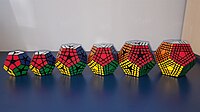Kilominx


The Kilominx[1][2][3] (also known as the Flowerminx, as branded by Mèffert's)[4] is a dodecahedral twisty puzzle in the style of the Rubik's Cube. It has a total of 20 movable pieces, same as the 3x3x3 Rubik's Cube, however all pieces on the Kilominx are corners, similar to those on the Pocket Cube.
Overview[edit]
The Kilominx is in the shape of a dodecahedron, with 12 pentagonal faces. The puzzle has a total of 20 visible pieces, all of which are corner pieces and have three colours each. Each face of the puzzle contains five corner pieces, one around each vertex of the pentagon. In the solved state, all twelve faces are of uniform colour.[4]
The objective of the Kilominx is to scramble the colours by moving the pieces around the puzzle, and then restore it to its original state of having one colour per face. Each move permutates five adjacent corner pieces around their shared face.[3][4]
Mechanically, the puzzle is similar to the Mégaminx, and in fact solving a Kilominx is equivalent to solving only the corners of a Mégaminx.[3] This is analogous to the Pocket Cube, which is like solving just the corner pieces of a Rubik's Cube.
Two different colouring versions of the Kilominx exist; one with 12 colours, where each face has a distinct colour, and one with 6 colours, where opposite faces have the same colour.[4] Mathematically speaking, having two faces with the same colour does not affect the difficulty of the puzzle. This is because any two corner pieces with the same colours have opposite chirality (i.e. they are mirror images of each other); therefore, even though the faces look the same, no two pieces of the puzzle are completely identical.[4] However, the six-colour version can be considered visually harder for solvers because some pieces are very similar, which can lead to confusion as to where each piece should be placed.
Variations[edit]


Several variations of the Kilominx have been made over the years.
Impossiball[edit]
Although branded and sold as a separate puzzle, the Impossiball is essentially a shape modification of the Kilominx.[4] It was designed by William O. Gustafson, who applied for a patent for the Impossiball design in 1981, which was issued in 1984.[5] Uwe Mèffert eventually bought the rights to some of the patents and mass-produced the puzzle soon after. The puzzle is in the shape of a sphere and has 20 rounded-triangular pieces, equivalent to the 20 corner pieces on the Kilominx. Instead of coloured faces, there are 12 coloured circles, locates at each of the points where five triangles meet. Like the Kilominx, this puzzle was sold in both six-colour and twelve-colour versions. Additionally, although this was likely not the intention of the manufacturer, it is also possible to remove one triangular piece of the Impossiball, effectively turning the puzzle into a spherical version of the 15 puzzle.[4]
Higher-order variations[edit]
The Kilominx is part of the Mégaminx puzzle family, which consists of other face-turning dodecahedral puzzles with a different number of layers. This includes the Master Kilominx (which has 4 layers) and Elite Kilominx (6 layers). Like the Kilominx itself, these puzzles are generally considered variations of the Mégaminx, although one common feature of the even-layer puzzles is their lack of "fixed" pieces, which leaves these puzzles with no identifiable orientation (see Number of combinations).
Number of combinations[edit]
There are a total of 20 corner pieces in the puzzle, which can be rearranged in 20! different ways. Only even permutations of these are possible (i.e. it is impossible to have just one pair of pieces swapped with the rest of the puzzle solved), which divides this number by 2.
Additionally, each corner piece can be orientated in 3 ways, giving a total of 320 possible corner orientations. Since the orientation of one corner is fully dependent on the orientation of the remaining nineteen, this number is divided by 3.
Also, since the Kilominx has no fixed pieces, this result is divided by 60. This is because there are 60 possible positions and orientations of the first given corner, but due to the lack of fixed "reference" pieces, all of these positions are rotationally symmetrical to each other.
The number of possible combinations on the Kilominx is therefore equal to:[4]
The full number is 23 563 902 142 421 896 679 424 000 (roughly 23.6 septillion on the short scale or 23.6 quadrillion on the long scale).[4]
Solutions[edit]
Despite the puzzle's shape and its greater number of possible positions, the Kilominx is not much more difficult than the Pocket Cube. This is because it is not a deep-cut puzzle; it only has pentagonal face layers which are similar in structure to the square face layers of the cube. There are no pieces that do not have a counterpart on the cube. Many of the techniques employed in the solution of the Pocket Cube can also be adapted for the Kilominx.[3][4]
See also[edit]
References[edit]
This article "Kilominx" is from Wikipedia. The list of its authors can be seen in its historical and/or the page Edithistory:Kilominx. Articles copied from Draft Namespace on Wikipedia could be seen on the Draft Namespace of Wikipedia and not main one.


